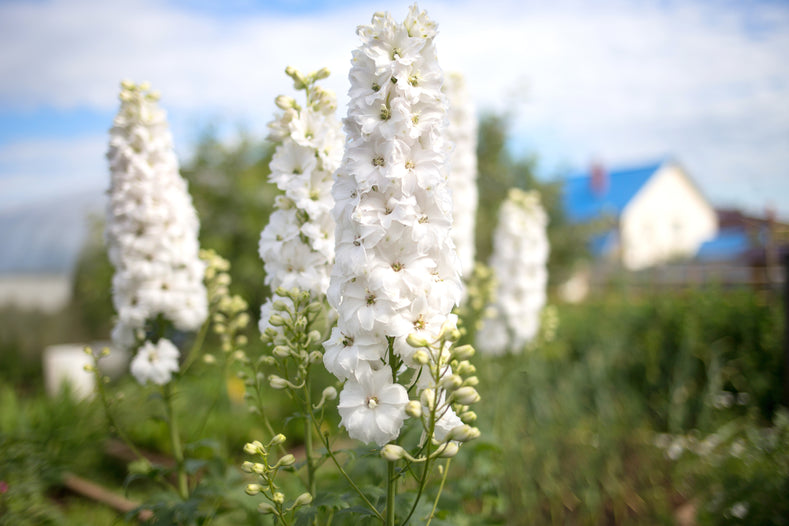Delphiniums are truly showstoppers in the home gardening world. They are best known for their tall, colorful flower spikes that can reach as high as six feet. Although they are best known for their blue flowers, they also come in shades of pink, purple, white, and others. One of our varieties, Delphinium Highlander Rainbow Sensation, varies in shade from pink to lilac to yellow.
Another common name for delphiniums is larkspur, although not all flowers that are called larkspur are part of the up to 300 varieties of the delphinium genus. The word “delphinium” is derived from the Greek word for “dolphin.” It is said that the plant got its name from its flower buds, which are shaped like dolphin noses. Here at Dutch Grown, we are proud to feature four different varieties of delphiniums.
Appearance
As mentioned above, larkspurs are characterized by their tall flower spikes that bloom from mid-summer to late fall. They come in both single and double bloom varieties. While the most common variety features blue flowers, they can come in many different colors, including violet, pink, red, and white. Larkspurs have little to no scent, although some gardeners will describe their scent as “clean.”
Growth Habits
Although delphiniums are a perennial, they are what is known as a short-lived perennial and only last two to three years. However, if given proper conditions, larkspurs will multiply. Every three years or so, you can dig up the roots to remove the old plant and replant the small shoots growing around the outside of the clump.
There are many different varieties of delphiniums. They range in size from tiny five-inch-tall flower spikes to towering six-foot giants, and they fit into a variety of garden settings.
Delphinium Care
Larkspurs can be finicky to grow, but their unmatched beauty is well worth the work. Transplants should be planted in Spring. They prefer full or partial sun and moist but well-draining soil. They are heavy feeders and prefer to be fertilized weekly. Flower stalks should be removed once they are done flowering. The roots can be left in the ground over winter, but you’ll want to mulch the plant in the fall. Larkspur love sunny spots but cool temperatures, so you’ll have to think carefully about the spot they’re planted in relation to your growing zone.
For more on delphinium care, read our blog post here.
How to Keep Delphiniums Blooming
For ideal flower spikes, thin larkspur’s side shoots at three inches, leaving only two or three shoots on young plants. This way, the plant can focus its energy on growing just a few tall spikes. Larkspur flower stalks should be staked to support their growth, and when flowers are finished blooming, you’ll want to cut the flower stalk to give the plant a chance to bloom again. Well-cared-for larkspurs will bloom a few times throughout the summer. For flower arrangements, blooms should be cut when buds begin to show color and open. They will last up to 8 days indoors.
Where to Plant Delphiniums
Delphiniums fit into a variety of gardens. If you grow in a small area or only have balcony space available, you can grow larkspurs in a container, as long as you choose one that’s big enough to support their growth. Shorter larkspur types make a great border in the front of other flowers while tall larkspur make a stunning backdrop to shorter plants in front.
Additionally, delphiniums make a charming addition to any cottage-style or cut flower garden. And, as they’re well known as being poisonous to both people and animals, they can make a fun addition to a “poison garden” somewhere on your property.
Why You Should Grow Delphiniums
Larkspur are without a doubt one of the most beautiful flowers that you can grow in your garden. Their tall flower spikes will outshine all the rest. And you won’t be the only one enjoying these beautiful blooms; butterflies and hummingbirds love delphiniums, too. You’ll bring in not only the beauty of larkspur but also wonderful wildlife that are beneficial to your garden. And you’ll be able to create beautiful flower arrangements for the inside of your home, too!




